11th Hour Racing Team in The Ocean Race
By Sean McNeill
The Ocean Race bills Leg 3 from Cape Town, South Africa, to Itajaí, Brazil (underway as this issue went to press) as a monstrous undertaking. At 12,750 nautical miles it is the longest leg in the 50-year history of the race, surpassing by 450 nautical miles Leg 5 from China to Brazil in the 2008-’09 race.
Racing in the deep latitudes of the Roaring Forties and Screaming Fifties, the so-called Southern Ocean legs are the ones that attract sailors to The Ocean Race (née Volvo Ocean Race, née Whitbread Round the World Race). The expanse of water from the Cape of Good Hope, at the southern tip of South Africa, to Cape Horn, at the southern tip of the Americas, and encircling Antarctica offers long wave periods and strong following winds, the type of planing conditions on which adrenaline junkies thrive.
The IMOCA Class has reveled in the conditions, illustrating through sheets of water the performance potential of the foil-aided 60-footers. During the span of March 5-12, the present race’s 24-hour distance record was smashed repeatedly. (The outright 24-hour race record of 602 nautical miles was set by AkzoNobel in the 2017-’18 race.)
First, 11th Hour Racing Team’s Mālama, skippered by Rhode Islander Charlie Enright, set a distance of 544.6 nautical miles between midnight UTC, March 4-5. The mark was a couple of miles better than the race record Mālama set on Leg 2, but before the ink could dry Mālama obliterated its own record, upping the distance to 586nm on March 11.
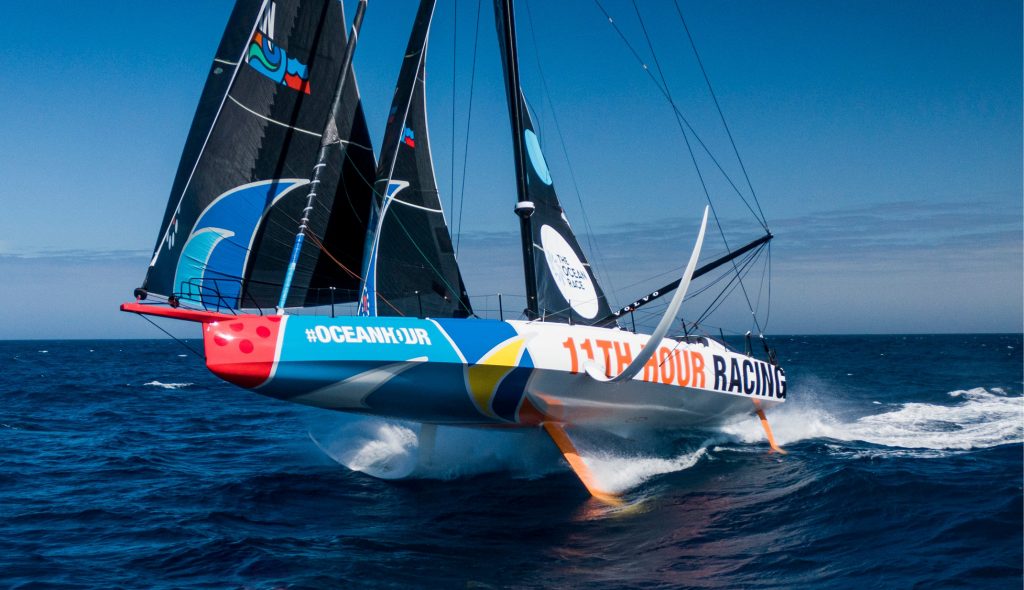
11th Hour Racing Team enjoying flat water and a building breeze at 45-degrees south. © Amory Ross/11th Hour Racing Team/The Ocean Race
Then, a day later, Kevin Escoffier’s overall race leader Holcim – PRB took it a couple steps further with a ratified distance of 594.82 nautical miles on March 12. Holcim – PRB’s mark is also a new IMOCA Class record for a crewed entry, easily outpacing the 539.71 miles set by Alex Thomson’s Hugo Boss in 2018 and the 536.81-nautical-mile record Thomson set singlehandedly in 2017.
The record-breaking runs were spurred on by highly motivated crews pushing each other hard towards the Leg 3 scoring gate as well as near perfect winds and relatively flat sea state. “Not sure we are ever going to be forced to reach in a straight line at 90 degrees true for 600 miles in 23 knots and flattish seas ever again!” said 11th Hour Racing Team onboard reporter Amory Ross (Newport, RI), to the envy of adrenaline junkies everywhere.
On the evening of March 12 UTC, Escoffier’s Team Holcim-PRB was first through the scoring gate at 143°E longitude. Holcim-PRB has led the fleet since leaving Cape Town on February 26 and at one point held a 600nm advantage over the fleet. Although its lead was under 100NM at the scoring gate, being first was a welcome result for the hard sailing the crew has endured and earned them an extra five points to expand their lead on the scoreboard.
“From the start in Cape Town to this scoring gate I think we’ve done very well to keep the other boats behind us,” Escoffier said on March 13. “We’ve also had an amazing 24-hour record. So, I’m very happy with the boat, very happy with the crew… and I think we deserve to enjoy, but now it’s back to work.”
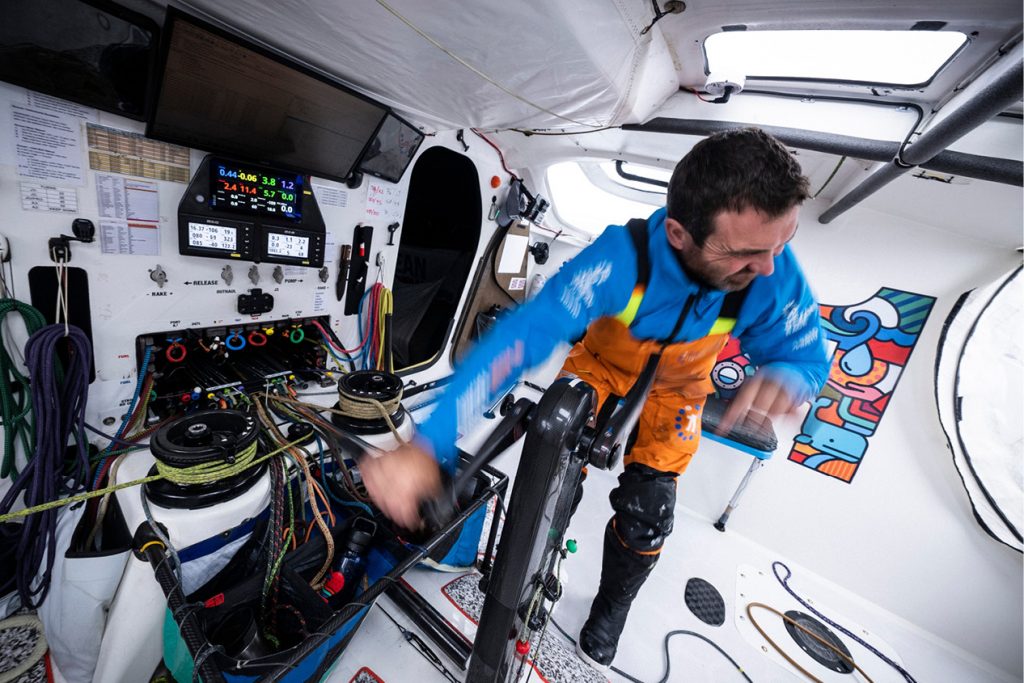
Skipper Charlie Enright grinding the mainsheet © Amory Ross/11th Hour Racing Team/The Ocean Race
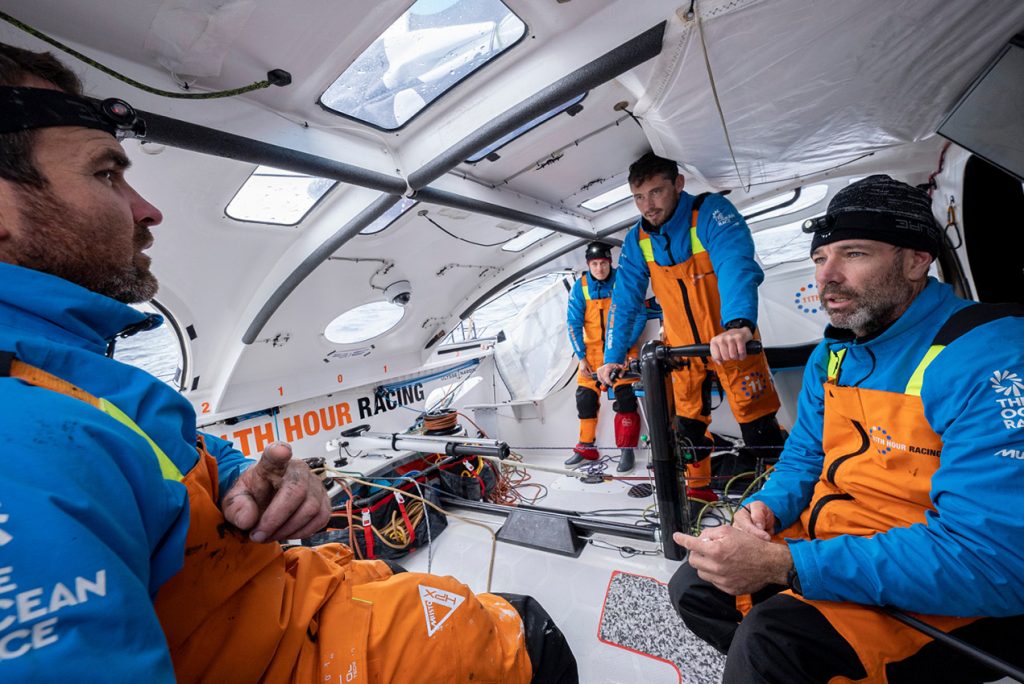
The team discusses their options after crossing the scoring gate south of Tasmania. © Amory Ross/11th Hour Racing Team/The Ocean Race
Boris Hermann’s Team Malizia from Germany passed 11th Hour Racing Team in close-quarters racing on March 12 to grab second place and earn 4 points at the gate, relegating 11th Hour Racing Team to third for 3 points.
“These conditions really suit them (Team Malizia),” Enright said. “We’ve been doing a nice job, but it’s hard. We’ve been sailing for 5,000 miles and it’s going to come down to these last couple hundred.”
Ross described Malizia’s superiority in the 20-25 knot winds from the northwest. “After working our way through Biotherm last night it was Malizia’s turn to do the same to us this afternoon. They seem to be able to carry more sail and keep their bow up, presumably with the shape of their hull, and while we struggled in the waves to keep from nosediving they were able to sail at the same speed but lower. We watched as they sailed down to us, around our bow, and then continued on in a more southerly direction.”
The standings will change when the leg concludes in Brazil, but currently Holcim-PRB leads with 15 points, 11th Hour Racing Team is second with 10 points, Malizia third with 9 points, and Paul Mielhat’s Biotherm fourth with 8 points after crossing through the gate in fourth place.
Skipper Benjamin Dutreux and the Guyot environment-Team Europe crew are fifth overall with 2 points. They were forced to retire from the leg barely four days into it when crew Annie Lush noticed the hull flexing as she was about to settle down off-watch.
“I was just coming off watch and I was just about to get into my bed and I could see on the opposite side of the boat there was a case tied to the floor and it was moving,” said Lush of Great Britain, who’s sailing her third edition of The Ocean Race. “I didn’t think I’d seen it move like that before and when I went to check I could hear the noise of delamination… We could hear it and see it moving up and down… We spoke to the architects and there is no way we can fix this out here, so we have to return to Cape Town.”
That the hull has suffered delamination of the carbon-fiber skin and Nomex core is somewhat unsurprising. Guyot environment-Team Europe is the former Hugo Boss, which was built in 2015 and raced by Thomson in the 2016-’17 Vendée Globe. It has also raced two Route du Rhums, two Transat Jacques Vabres, two Rolex Fastnet Races and The Ocean Race Round Europe race, among other racing and testing/training, so it has racked up some miles. Newer IMOCAs are being built with solid carbon hulls in the hopes of avoiding such delamination. The boat was under repair in South Africa and will be shipped to Brazil for Leg 4 to Newport, RI, starting April 23.
The crew of Mālama, the lone U.S. entry in the race, has had its share of battles this leg. The trouble started shortly after the February 26 start from Cape Town when two battens supporting the square-top mainsail broke, forcing the team to suspend racing for two hours to replace them.
They’ve also suffered problems with the board downhaul lines, the keel canting system, and tears to the J2 and J3 headsails. Significantly, they also have a tear in the mainsail at the luff near the first reef point, which means they won’t be able to use a full mainsail the remainder of the leg, and they also have cracks in both rudders.
The rudder cracks were discovered on March 8 during a full boat inspection in relatively calm conditions. 11th Hour Racing Team replaced both of its hydrofoil boards before the start of the leg due to cracks found after the first two legs, so the cracks in the rudders came with alarm.
The crew found two cracks on the starboard rudder – from front to back, midway down on the outboard side, and another, smaller crack closer to the “root,” where the rudder meets the boat – and one on the port rudder – a bigger one at the top similar to the upper crack on the starboard rudder.
The crew consulted with the shore team and decided to replace the starboard rudder with the onboard spare, and then set off for five days of high-speed sailing on port jibe. After passing through the scoring gate, Enright described the options to the crew.
“We have a number of different things hampering our performance at the moment. We did actually talk about stopping, whether it be in New Zealand, Tasmania. But ultimately decided that it is safe to proceed. Given the weather that we have ahead of us, there will still be some opportunities to execute repairs and then we will see what the future brings.
“We have got to remember as a group that we are here engaging in one of life’s last great adventures, and we are doing it together as a squad,” Enright continued. “We need to enjoy it and certainly enjoy each other’s company. It has been a lot of hard work just to get to this point. We have put a lot of hard hours into this boat, too. From a competitive standpoint, we’ll have more than one hand tied behind our backs…but we understand that. We’ll chip away with what we can along the way. It’s not over yet, not by a long way.”
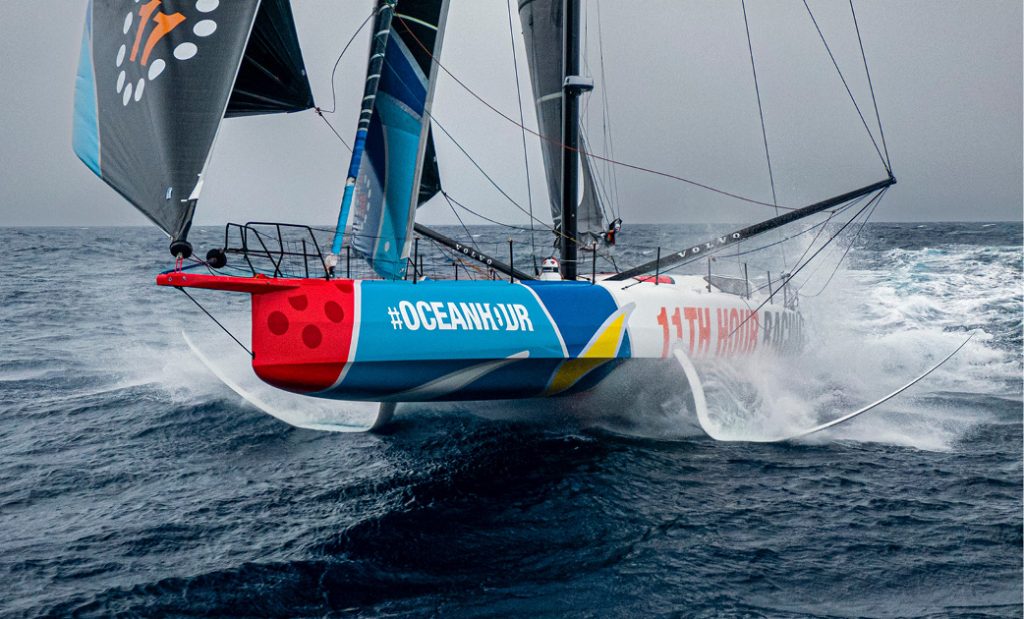
Mālama flies downwind in the Southern Ocean. © Amory Ross/11th Hour Racing Team/The Ocean Race
The fleet is expected in Itajaí sometime in late March/early April. Upon finishing the crews will get a well-earned break of two-to-three weeks before Leg 4, from Itajaí to Newport, begins April 23. For the third consecutive edition of the race, Newport will be the lone stopover in North America. The estimated finishing time in Newport is between May 8-11, and the Ocean Live Park at Fort Adams State Park will be open May 13-21. Visit theoceanracenewport.com/ for information specific to the Newport stopover. ■
Based in Newport, RI, Sean McNeill is an independent writing and editing professional.
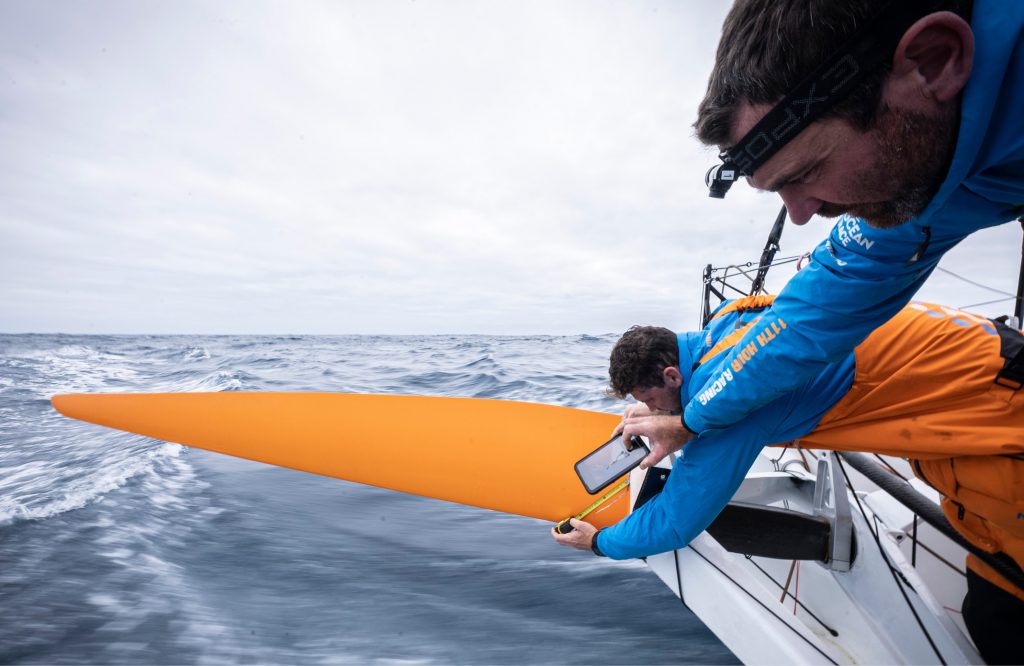
Checking the port rudder’s crack for growth after a week of heavy air sailing. © Amory Ross/11th Hour Racing Team/The Ocean Race
